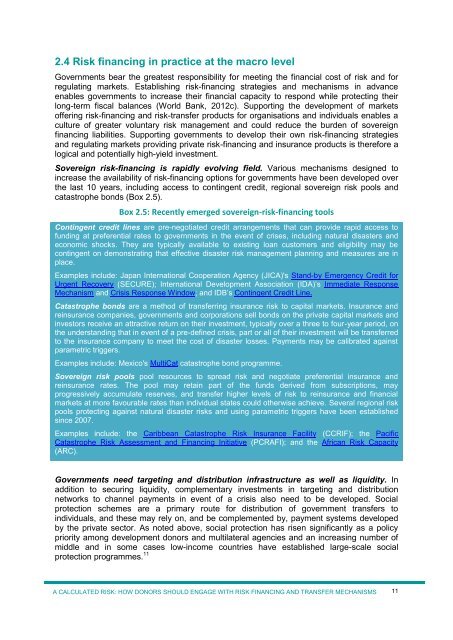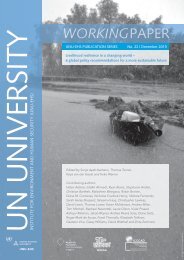k5q82a3
k5q82a3
k5q82a3
Create successful ePaper yourself
Turn your PDF publications into a flip-book with our unique Google optimized e-Paper software.
2.4 Risk financing in practice at the macro level<br />
Governments bear the greatest responsibility for meeting the financial cost of risk and for<br />
regulating markets. Establishing risk-financing strategies and mechanisms in advance<br />
enables governments to increase their financial capacity to respond while protecting their<br />
long-term fiscal balances (World Bank, 2012c). Supporting the development of markets<br />
offering risk-financing and risk-transfer products for organisations and individuals enables a<br />
culture of greater voluntary risk management and could reduce the burden of sovereign<br />
financing liabilities. Supporting governments to develop their own risk-financing strategies<br />
and regulating markets providing private risk-financing and insurance products is therefore a<br />
logical and potentially high-yield investment.<br />
Sovereign risk-financing is rapidly evolving field. Various mechanisms designed to<br />
increase the availability of risk-financing options for governments have been developed over<br />
the last 10 years, including access to contingent credit, regional sovereign risk pools and<br />
catastrophe bonds (Box 2.5).<br />
Box 2.5: Recently emerged sovereign-risk-financing tools<br />
Contingent credit lines are pre-negotiated credit arrangements that can provide rapid access to<br />
funding at preferential rates to governments in the event of crises, including natural disasters and<br />
economic shocks. They are typically available to existing loan customers and eligibility may be<br />
contingent on demonstrating that effective disaster risk management planning and measures are in<br />
place.<br />
Examples include: Japan International Cooperation Agency (JICA)'s Stand-by Emergency Credit for<br />
Urgent Recovery (SECURE); International Development Association (IDA)’s Immediate Response<br />
Mechanism and Crisis Response Window; and IDB’s Contingent Credit Line.<br />
Catastrophe bonds are a method of transferring insurance risk to capital markets. Insurance and<br />
reinsurance companies, governments and corporations sell bonds on the private capital markets and<br />
investors receive an attractive return on their investment, typically over a three to four-year period, on<br />
the understanding that in event of a pre-defined crisis, part or all of their investment will be transferred<br />
to the insurance company to meet the cost of disaster losses. Payments may be calibrated against<br />
parametric triggers.<br />
Examples include: Mexico's MultiCat catastrophe bond programme.<br />
Sovereign risk pools pool resources to spread risk and negotiate preferential insurance and<br />
reinsurance rates. The pool may retain part of the funds derived from subscriptions, may<br />
progressively accumulate reserves, and transfer higher levels of risk to reinsurance and financial<br />
markets at more favourable rates than individual states could otherwise achieve. Several regional risk<br />
pools protecting against natural disaster risks and using parametric triggers have been established<br />
since 2007.<br />
Examples include: the Caribbean Catastrophe Risk Insurance Facility (CCRIF); the Pacific<br />
Catastrophe Risk Assessment and Financing Initiative (PCRAFI); and the African Risk Capacity<br />
(ARC).<br />
Governments need targeting and distribution infrastructure as well as liquidity. In<br />
addition to securing liquidity, complementary investments in targeting and distribution<br />
networks to channel payments in event of a crisis also need to be developed. Social<br />
protection schemes are a primary route for distribution of government transfers to<br />
individuals, and these may rely on, and be complemented by, payment systems developed<br />
by the private sector. As noted above, social protection has risen significantly as a policy<br />
priority among development donors and multilateral agencies and an increasing number of<br />
middle and in some cases low-income countries have established large-scale social<br />
protection programmes. 11<br />
A CALCULATED RISK: HOW DONORS SHOULD ENGAGE WITH RISK FINANCING AND TRANSFER MECHANISMS<br />
11



